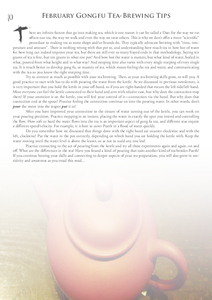
 |
|
There are infinite factors that go into making tea, which is one reason it can be called a Dao: for the way we eat affects our tea, the way we walk and even the way we treat others. This is why we don't offer a more "scientific" procedure to making tea as some shops and/or brands do. They typically advocate brewing with "time, temperature and amount". There is nothing wrong with that per se, and understanding how much tea in how hot of water for how long can indeed improve your tea, but there are still ever so many frayed ends in that methodology. Saying ten grams of tea is fine, but ten grams in what size pot? And how hot the water is matters, but what kind of water, boiled in what, poured from what height and in what way? And steeping time also varies with every single steeping of every single tea. It is much better to develop gong fu, or mastery of tea, which means feeling the tea and water, and communicating with the tea so you know the right steeping time. Try to connect as much as possible with your tea brewing. Then, as your tea brewing skills grow, so will you.

A good practice to start with has to do with pouring the water from the kettle. As we discussed in previous newsletters, it is very important that you hold the kettle in your off-hand, so if you are right-handed that means the left side/left hand. Most everyone can feel the kettle connected to their hand and arm with relative ease, but why does the connection stop there? If your attention is on the kettle, you will feel your control of it - connection via the hand. But why does that connection end at the spout? Practice feeling the connection continue on into the pouring water. In other words, don't pour the water into the teapot put it in!
After you have improved your connection to the stream of water coming out of the kettle, you can work on your pouring precision. Practice stopping in an instant, placing the water in exactly the spot you intend and controlling the flow. How soft or hard the water flows into the tea is an important aspect of gong fu tea, and different teas require a different speed/velocity. For example, it is best to cover Puerh in a flood of water quickly.
Do you remember how we discussed that things done with the right hand are counter-clockwise and with the left, clockwise? Put the water in the pot correctly, depending on which hand you are holding the kettle with. Keep the water moving until the water level is above the leaves, so as not to scald any one leaf.
Practice connecting to the act of pouring from the kettle and try all these experiments again and again, on and off. What are the differences in the tea? Have you found a kind of pouring that suits another kind of tea besides Puerh? If you continue honing your skills and connecting to deeper aspects of your tea preparation, you will also grow in sensitivity and awareness as you tread this road...
